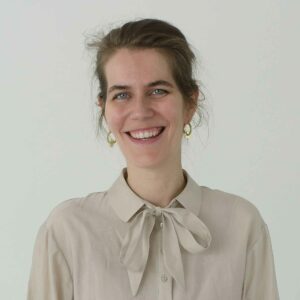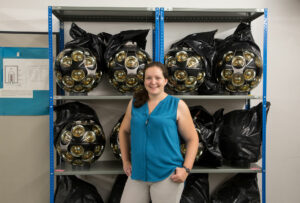Two ERC Starting Grants for Prof. Dr. Anna Nelles and Dr. Flore Kunst
Neutrino Research and Non-Hermitian Topological Phenomena.
Grants from the European Research Council (ERC; Europäischer Forschungsrat) are highly competitive. Receiving them not only gives new impetus to the research of the awarded scientists through the high funding sums of up to 1.5 million euros over 5 years – it also distinguishes the recipients as top researchers in their fields. The five award winners from FAU include Prof. Dr. Anna Nelles, Professor of Experimental Astroparticle Physics, and Dr. Flore Kunst from the Max Planck Institute for the Physics of Light.
In search of cosmic neutrinos
Prof. Dr. Anna Nelles, Professor of Experimental Astroparticle Physics at FAU. (Picture: FAU/Georg Pöhlein)
Prof. Dr. Anna Nelles, who is a professor of Experimental Astroparticle Physics at FAU and also works as a scientist at the Deutsches Elektronen-Synchrotron DESY in Zeuthen (host institution for the ERC grant), is building a network of radio antennas on Greenland to eavesdrop on extremely energetic neutrinos from space. Neutrinos are volatile elementary particles that can be stopped by almost nothing. They pass unhindered through walls, planets and entire galaxies and therefore reach us from the farthest corners of the cosmos and from the center of extreme processes such as supernova explosions of stars or from the dust disks around black holes. Some of these particles have as much energy as a sharply hit ping-pong ball. Experiments have shown that the fast neutrinos leave behind radio waves on their way through the atmosphere as well as the Greenland ice sheet, which can be picked up with special antennas.
“The discovery of neutrinos at extreme energies promises new insights in both astrophysics and particle physics at energies far beyond those achievable with terrestrial particle accelerators,” Nelles explains. “With such observations, we hope to reveal new sources of extremely energetic cosmic rays and better understand the propagation of these particles in space.” The “Radio Neutrino Observatory – Greenland” RNO-G will be the first large facility of its kind and is expected to expand to 35 stations by 2026. Construction and operation will be led by Nelles and colleagues from the United States and Belgium.
Dr. Anna Nelles has been a professor of Experimental Astroparticle Physics, in particular radio detection of neutrinos, at FAU since 2019; at the same time, she works as a scientist at DESY in Zeuthen. Nelles studied physics at RWTH Aachen University as well as economics (MBA) before earning her PhD in physics at the University of Nijmegen, the Netherlands. She then went to the University of California as a postdoc in 2015. Her last position before FAU was as an Emmy Noether group leader at Humboldt-Universität zu Berlin.
That a donut is also a cup, Flore Kunst can prove it
Dr. Flore Kunst has also been awarded a Starting Grant from the European Research Council (ERC). In addition, along with two other candidates, she receives one of the coveted places in the Max Planck Society’s (MPG) Lise Meitner Excellence Program 2.0 and sets up her own independent junior research group. In doing so, the physicist and young scientist at the Max Planck Institute for the Physics of Light is rapidly attracting research funding totaling 4.5 million euros.

Her research area “Non-Hermitian Topological Phenomena” is a young research field that is dynamically developing and steadily gaining in importance. As a fundamental discipline of mathematics, topology deals with the properties of geometric objects that are preserved when they are deformed. For example, the shape of a donut can easily be transformed into a cup from a mathematical point of view: Both objects have exactly one hole, so they have the same topology. Now, however, Flore Kunst considers the topology of systems that are not closed -non-hermitian- and interact with their environment. In real systems, this occurs, for example, through the exchange of particles or energy.
Specifically, her work aims to go beyond closed, lossless systems, both in the single-particle and many-particle picture. The mathematical description of these open systems is extremely complex. In quantum optics or even in the description of open quantum systems, the use of non-Hermitian models is indispensable. With them, the complexity of interacting systems can be described much more easily.
Flore Kunst grew up in the Netherlands and studied at Utrecht University. Afterwards, she did her PhD first at the Free University of Berlin and later at Stockholm University under the supervision of Professor Bergholtz. Since October 2019, she has continued her research at the Max Planck Institute of Quantum Optics. At the end of 2021, the physicist started her new research area “Non-Hermite Topological Phenomena” at the Max Planck Institute for the Physics of Light.
Contact:
Dr. Flore Kunst
Flore Kunst@mpl.mpg.de
Prof. Dr. Anna Nelles
anna.nelles@fau.de

